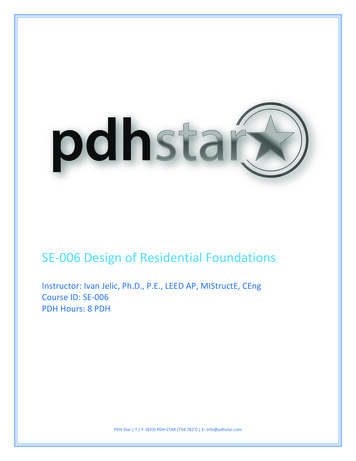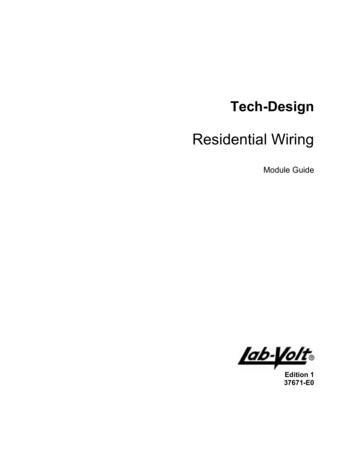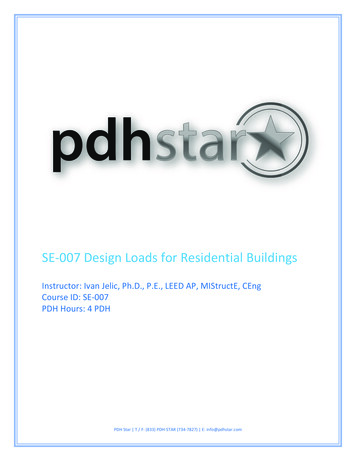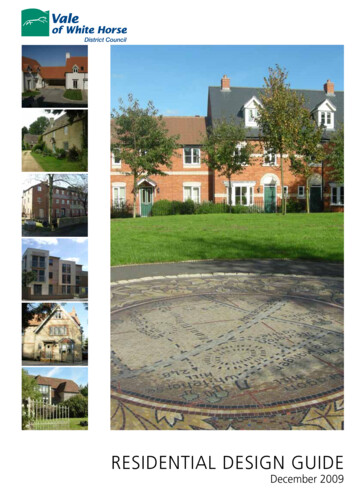
Transcription
Foundation Design Options forResidential and Other LowRise Buildings on ExpansiveSoils7Professional Development Hours (PDH)orContinuing Education Hours (CE)Online PDH or CE courseFDA, Inc.
2TABLE OF CONTENTS1.0 INTRODUCTION52.0 PROBLEM DEFINITION63.0 GENERAL DESIGN CONSIDERATIONS74.0FOUNDATION SYSTEM DESIGN OPTIONS84.1DEEP SUPPORT SYSTEMS84.1.1 Isolated Structural Systems with Deep Foundations94.1.1.1 Structural Slab with Void Space and Deep Foundations94.1.1.2 Structural Floor with Crawl Space and Deep Foundations114.1.2 Stiffened Structural Slab with Deep Foundations134.1.3 Stiffened Non-Structural Slab with Deep Foundations144.1.4 Non-Stiffened Slab-on-Grade with Deep Foundations154.2SHALLOW SUPPORT SYSTEMS154.2.1 Grade-Supported Stiffened Structural Slab164.2.2 Grade-Supported Stiffened Non-Structural Slab174.2.3 Grade-Supported Non-Stiffened Slab of Uniform Thickness184.3MIXED DEPTH SYSTEMS194.3.1 Mixed Depth System for All-New Building Construction194.3.2 Mixed Depth System for Building Additions with Deep Foundations204.3.3 Mixed Depth System for Building Addition with Shallow Foundations 205.0FOUNDATION COMPONENT DESIGN OPTIONS225.1DEEP SUPPORT COMPONENTS225.1.1 Drilled and Underreamed Concrete Piers225.1.2 Drilled Straight-Shaft Concrete Piers235.1.3 Auger-Cast Concrete Piles255.1.4 Displacement Piles265.1.5 Helical Piers275.2SLAB AND GRADE BEAM REINFORCING285.2.1 Post-Tensioned Reinforcing295.2.2 Deformed Bar Reinforcing305.2.3 Welded Wire Fabric Reinforcing315.2.4 Fiber Reinforced Concrete325.2.5 Unreinforced Concrete 325.3VOID SYSTEMS UNDER GRADE BEAMS AND PIER CAPS325.4VAPOR RETARDERS335.5GRADE-BEAM-TO-PIER CONNECTIONS335.5.1 Grade-Beam-to-Pier Connections with No Restraints335.5.2 Grade-Beam-to-Pier Connections with Horizontal-Only Restraints345.5.3 Grade-Beam-to-Pier Connections with Horizontal and Vertical Restraints 34FDA, Inc.
36.0FOUNDATION SITE DESIGN OPTIONS6.1MOISTURE CONTROL SYSTEMS6.1.1 Site Drainage Systems6.1.1.1 Site Grading6.1.1.2 French Drains6.1.1.3 Area Drains6.1.2 Moisture Retarder Systems6.1.2.1 Horizontal Moisture Retarders6.1.2.2 Vertical Moisture Retarders6.1.3 Watering Systems6.1.3.1 Sprinkler Systems6.1.3.2 Soaker Hose Systems6.1.3.3 Under-Slab Watering Systems6.1.3.4 Drip Watering Systems6.2VEGETATION CONTROL SYSTEMS6.2.1 Root Retarder Systems6.2.1.1 Vertical Root Retarders6.2.1.2 Horizontal Root Retarders6.2.2 Root Watering Wells6.3TREE AND PLANT SELECTIONFDA, Inc.3535353535363637373838383939404040414242
4FOUNDATION DESIGN OPTIONS FORRESIDENTIAL AND OTHER LOW-RISEBUILDINGS ON EXPANSIVE SOILSFDA, Inc.
51.0 INTRODUCTIONThe scope of this document is to provide guidance in the selection of design options forresidential and other low-rise building foundations, typically called light foundations, which arefounded on expansive soils. Low-rise buildings are defined as one to four stories in height. Thesebuildings include houses, garages, apartment and condominium buildings, restaurants, schools,churches, and other similar structures. Design options for foundation systems, foundationcomponents, and moisture and vegetation control methods are reviewed and compared. There areno absolute design rules for choosing a design. This document provides a list of advantages anddisadvantages for each of the many commonly used foundation design options to assist thedesigner in selecting the most suitable option.A brief overview of the design problems associated with expansive soils is provided in Section2.0, and general design considerations are presented in Section 3.0. The foundation designoptions are categorized into three separate sections. Section 4.0 covers foundation system designoptions considering the structural foundation system as a whole. The foundation systems aresubdivided into two groups: deep support systems and shallow support systems. Section 5.0addresses design options for various individual structural components of the foundation systemsthat are discussed in Section 4.0. Section 6.0 discusses site design options for moisture andvegetation control systems.Foundation design options for heavily loaded structures such as mid- to high-rise buildings orlarge industrial structures that usually require deep foundations or thick large mat foundationsare not addressed, nor are design options for lightly loaded structures that are not susceptible tosignificant damage due to differential vertical movements from soil moisture changes, such asrelatively flexible light gage metal buildings with exterior metal siding and roofing and wideopen interior spaces with no interior partition walls.FDA, Inc.
62.0 PROBLEM DEFINITIONThe challenge with designing building foundations on moderate to highly expansive clay soils isthe potential detrimental effects of differential movements of the foundation structural elementsdue to volumetric changes of the underlying and surrounding soils. In simple terms, expansiveclay soils swell and can cause heave with increasing soil moisture or can dry out and causesubsidence with decreasing soil moisture.Movement of expansive soils is caused by fluctuations in the moisture content of soil particles.Because homogeneous expansive clay soils have very low permeability, fluctuations in themoisture content of the soils might normally be expected to occur over a very long period.However, permeability is increased with geotechnical phenomena such as ground faults, surfacefractures due to desiccation of clays, and decomposition of tree roots which cause fissures andcracks that become widely disseminated over time.Due to the repeated wetting, swelling, drying, and shrinking of the clay as it weathers, thefissures often fill with silt and sand, and create pathways for water that can exacerbate theinfiltration process. Water can also easily move through naturally occurring sand strata, sandseams, and micro-cracks in clay soil caused by previous shrinkage. High negative pressures, alsoknown as suction, in clay soils with low water content also increase the tendency for water to beabsorbed into the clay.Environmental factors other than climatic conditions can also affect expansive soils. Waterextraction by trees and other vegetation, a process known as transpiration, can cause soilshrinkage. Swelling can be a result of water infiltration into the soil from lawn irrigationsystems, broken water pipes, flooded and leaking utility trenches, poor drainage, or leakingswimming pools, or it can be a result of slow moisture replenishment and equalization after theremoval of a tree. The combined effect and variability of all of these possibilities make itdifficult to accurately predict expansive soil ground movements.Foundation movements are considered problematic only if they result in negative phenomenathat detrimentally affect the performance or appearance of the building. The negative phenomenaare considered to be structural if the load carrying capacity of the superstructure or foundationelements are affected or are considered to be cosmetic if only the appearance of the exteriorcladding or interior wall, floor, or ceiling finishes are affected. Negative phenomena can alsoaffect the serviceability the building, such as the opening or closing of doors.Negative phenomena due to foundation movement typically occur because of differentialmovements between various parts of the building. Differential movements often lead to highinternal stresses in building components resulting as distress in the form of cracks, splitting,bending, buckling, or separations in the exterior cladding systems such as brick, cement-boardpanels, or in the interior finishes such as gypsum drywall panels, wood paneling, and flooring.FDA, Inc.
73.0 GENERAL DESIGN CONSIDERATIONSAside from supporting the building loads, the goal of structural foundation design in expansivesoil areas should be to economically mitigate the detrimental effects of foundation movement.This can be done by either isolating elements of the foundation system from potential soilmovements or by utilizing design methods and details that help to control the effects of themovement of the soil.Movements of expansive clay soils are generally restricted to an upper zone of soils known asthe active zone. The lower boundary of this zone is commonly defined as the line of zeromovement. The depth of the active zone varies from site to site. In the Houston area, this depth isthought to range from 8 to 20 feet. The depth of the active zone is an important design parameterused in the engineering design of foundations on expansive soils, particularly when planning touse deep foundations.Another general design consideration is the effect of the magnitude of surcharge pressure on thedegree of swell that can occur. Lightly loaded foundation components, such as concrete flatwork,pavements, and building slab-on-grade floors, are impacted more by expansive soil volumetricchanges than are heavily loaded foundation components such as heavily loaded bearing walls.Heavy loads reduce the amount of swell than can occur.Numerous foundation system design options are available that meet these goals to varyingdegrees. Many options are also available in the design and selection of components that make upthese foundation systems; however, choices should be based upon an engineered geotechnicalinvestigation. Different options are also available in the design of the site around the foundationand the selection of landscaping components. Advantages and disadvantages of these options arediscussed in the following sections.FDA, Inc.
84.0 FOUNDATION SYSTEM DESIGN OPTIONSThis section discusses the various types of foundation systems that are commonly used forresidential and other low-rise buildings in the Houston area where expansive soils occur. In thisdocument, the foundation system is considered to include the structural floor framing system ator near grade level and all other structural components beneath the building. The buildingsuperstructure consists of all structural elements above the grade level floor.The foundation systems are subdivided into two groups: deep support systems and shallowsupport systems. Each of these systems has an associated level of risk of damage that can occurto the building superstructure and architectural components due to differential foundationmovements. Each of these systems also has an associated relative cost of construction. Whencomparing the various foundation systems, the level of risk is typically found to be inverselyproportional to the level of cost. Higher risks are often accepted due to economic considerations.For example, shallow support systems typically have a relatively higher level of risk than deepsupport systems but are often selected due to economics and affordability.Because risk of damage and economic considerations are involved, building owners and/ordevelopers need to be involved in the selection process of the foundation system. To assist in thisselection, the foundation systems are generally listed in the order of increasing levels ofassociated risk and decreasing levels of construction cost.4.1 DEEP SUPPORT SYSTEMSDeep support systems are defined as foundations having deep components such as drilled piersor piles that extend well below the moisture active zone of the soils. They function to limit thevertical movements of the building by providing vertical support in a soil stratum that is notsusceptible to downward movements caused by moisture fluctuations.FDA, Inc.
94.1.1 Isolated Structural Systems with Deep FoundationsIsolated structural systems are characterized as having a superstructure and a grade levelstructural floor system that are designed to be physically isolated from the effects of verticalmovements of expansive soils. This is accomplished by providing sufficient space between thebottom of the floor system components and the top of the soil that will allow the underlyingexpansive soil to heave into the space or subside without causing movement of the floor system.The structural floor system usually consists of a reinforced concrete slab with a void formingsystem and series of grade beams. Other types of materials and framing systems can be usedsuch as a crawl space, which is created by constructing the floor system above the ground.4.1.1.1 Structural Slab with Void Space and Deep FoundationsThis foundation system typically consists of a structural reinforced concrete slab with cardboardcarton forms that create a void space that separates the slab from the surface soils. The depth ofthe void forms ranges from four to eight inches and depends on the expansiveness of the soils.The more expansive the soil (i.e. the higher the plasticity index), the deeper the cardboard cartonforms needed. The slab is called a “structural slab” because it spans between reinforced concretegrade beams that are supported entirely by deep foundations.Because of the relatively small void space that is used with this system, the bottom portion of thegrade beams are normally cast directly on the soil, even though they are designed to spanbetween the deep foundations. The slabs typically range in thickness from four to eight inches.The reinforcement can consist of a single or double mat of rebar. The structural slab is designedin accordance with the American Concrete Institute (ACI) publication, Building CodeRequirements for Structural Concrete, ACI 318.Void forms serve as formwork for the placement of concrete by acting as a temporary platformthat supports the weight of the wet concrete. Void forms typically are made of corrugated paperarranged in an open cell configuration. The exterior surface may be waxFDA, Inc.
10impregnated to temporarily resist moisture. The forms are specifically designed to gradually absorbground moisture, lose strength, disintegrate over time, and leave a void between the expansive soils andthe concrete slab. If the soil below the concrete heaves, it can expand into the space created by the voidform without lifting the foundation.TABLE 4.1.1.1STRUCTURAL SLAB WITH VOID SPACE AND DEEP FOUNDATIONSADVANTAGES *1. Reduces vertical movements ofslab-at-grade due to expansivesoils provided a sufficient void ismaintained under slab and thesupporting deep foundations arefounded sufficiently below activezone.2. Usually outperforms any othertype of foundation system.3. Reduces, but does not eliminate,need for a foundationmaintenance program.4. More rigid than a timber framedfloor with crawl space and deepfoundations, resulting in lessdifferential movement ofsuperstructure.5. Allows a void underapproximately 80–90% offoundation when void cartons arenot used under grade beams.6. No need for select structural fill.Fill can be comprised ofexpansive or non-expansive soil.Fill need only be compacted to adensity sufficient to support slabduring setup.DISADVANTAGES *1. Usually results in higherconstruction cost.2. Can require additional engineeringdesign effort than a slab-on-gradeand can result in higher engineeringfees.3. Extra time required to constructstructurally isolated floor canlengthen overall constructionschedule.4. Improper carton form installationcan result in void that is insufficientto provide for anticipated soilexpansion.5. Termites can be attracted to moistcardboard of carton forms.6. Grade beams that are in contact withsoil can heave due to swelling ofexpansive soils.7. Depending on slab elevation, canallow water to collect below slab.* Compared to other foundation systems as described in Sections 4.1.1 to 4.2.3.FDA, Inc.COMMENTS1. Slab is constructed about 4 to 8 inchesabove the soil using void cartonforms.2. Slab is designed to span betweengrade beams. Grade beams aredesigned to span between deepfoundations.3. Slab is more heavily reinforced thannon-structural slab.4. Vapor retarders such as polyethylenesheathing should not be placed belowcarton forms. Vapor retarders shouldbe placed above carton forms in orderto allow moisture to degrade voidboxes.5. Usually constructed with no cartonforms below grade beams due topotential water infiltration into voidand down shafts of deep foundations.6. Installation of an expendable hardsurface above carton forms such asMasonite sheeting will facilitateconstruction.
114.1.1.2 Structural Floor with Crawl Space and Deep FoundationsThis foundation system is similar to the previous system, except that the vertical space used toisolate the floor system is much larger, usually at least 18 inches, which is sufficient to allowaccess underneath the floor, hence the name "crawl space". The structural floor system can beconstructed utilizing any of the following common structural components: (a) wood subfloor andjoists supported by wood, steel, or concrete beams; (b) concrete floor slab and joists supportedby concrete beams; or (c) steel deck and open web bar joists or cold-formed sections supportedby steel or concrete beams. Other combinations of these floor-framing components are possible,and other materials can be used such as precast concrete planks orT-sections.FDA, Inc.
12TABLE 4.1.1.2STRUCTURAL FLOOR WITH CRAWL SPACE AND DEEP FOUNDATIONSADVANTAGES *1. Reduces vertical movement ofslab-at-grade due to expansivesoils, provided sufficient crawlspace is maintained under slaband supporting deep foundationsare founded sufficiently belowactive zone.2. Usually outperforms any othertype of foundation system.3. Reduces, but does not eliminate,need for foundation maintenanceprogram.4. Void cartons are not requiredunder the floor.5. No need for select structural fill.6. Accommodates certainarchitectural styles with raisedfirst floors.7. Exposed below-floor plumbing isaccessible.8. More suitable for flood-proneareas since ground floor isgenerally higher than for otherfoundation systems.DISADVANTAGES *1. Usually results in highestconstruction cost.2. Requires more extensive designeffort and will result in higherengineering fees.3. Takes longer to construct because itis labor intensive.4. Void below floor can collect water ifnearby grade or other surroundingsites are at a higher elevation.5. Less rigid than a stiffened slab,which can allow more differentialmovement of superstructure, causingmore cosmetic distress.6. Crawl space can allow sufficientoxygen for roots to grow, which cancause soil shrinkage.7. Proper drainage must be provided incrawl space.8. Exposed below-floor plumbing canfreeze.COMMENTS1. Ground floor is typically constructed30 to 42 inches above grade but canbe greater.2. Floor beams typically consist of steel,concrete, or wood beams spanningbetween piers over a 12–30-inch highcrawl space.3. Also known as Post-and-Beam,Block-and-Beam, Block-andBase, or Pier-and-Beam.4. Flooring typically consists of woodframing, steel framing, precastconcrete planks, or precast doubletees.5. Crawl space should be ventilated toevaporate moisture, whichaccumulates due to natural soilsuction, drainage problems, andplumbing leaks.6. Usually constructed with no cartonforms below grade beams due topotential water infiltration into voidand down shafts of deep foundations.7. Vapor retarders, such as polyethylenesheathing, are not recommended to beused to cover soils within crawl space.9. Floor is easier to level than a slabon-grade or structural slab withvoid space.10. Helps to preserve nearby existingtrees by allowing oxygen to rootzones.11. Allows a void underapproximately 95% of foundationwhen void cartons are not usedunder grade beams, or nearly100% when all beams are raisedcompletely above grade.12. Reduces settlement from soilshrinkage.* Compared to other foundation systems as described in Sections 4.1.1 to 4.2.3.FDA, Inc.
134.1.2 Stiffened Structural Slab with Deep FoundationsThe stiffened structural slab with deep foundations is the same as the structural slab with voidspace and deep foundations with the following exception: the slab is placed, without a void, overthe expansive soils and new fill, and the foundation must be designed to accommodate thepressures from the swelling soils. The foundation is designed as a “stiffened” slab. The gradebeams form a grid-like or “waffle” pattern in order to increase the foundation stiffness andreduce the potential bending deflections due to upward movement of the foundation.Using continuous grade beams in a grid-like fashion helps to reduce differential deflections. Thedeep foundations are used to minimize downward movement, or settlement, caused by shrinkingsoils. The stiffened structural slab with deep foundations should be designed to resist heave inaccordance with the BRAB 33 (Building Research Advisory Board), Wire ReinforcementInstitute (WRI) publication, Design of Slab-on-Ground Foundations; the ACI publication,Design of Slabs on Grade, ACI 360R, or the Post-Tensioning Institute (PTI) publication, Designand Construction of Post-Tensioned Slabs-on-Ground.TABLE 4.1.2STIFFENED STRUCTURAL SLAB WITH DEEP FOUNDATIONSADVANTAGES *1. Compaction of new fill belowslab not as critical and eliminatesneed for removing existing noncompacted fill.DISADVANTAGES *1. Does not limit heave that can occur.2. Requires additional design effort andhigher design and construction cost.2. Fill can be comprised ofexpansive or non-expansive soil.Fill need only be compacted to adensity sufficient to support slabduring setup.COMMENTS1. Slab is designed to span betweengrade beams. Grade beams aredesigned to span between deepfoundations.2. Slab is typically 4 to 8 inches thick,beam spacing is less, and slab is moreheavily reinforced than for stiffenedslab on fill.3. Stiffening grade beams should becontinuous across slab.3. Reduces settlement from soilshrinkage.4. Slab is more heavily reinforced thannon-structural slab.5. Is not designed to prevent foundationtilt.* Compared to other foundation systems as described in Sections 4.1.1 to 4.2.3.FDA, Inc.
144.1.3 Stiffened Non-Structural Slab with Deep FoundationsThis type of foundation system is a stiffened concrete slab that can bear on non-expansive selectstructural fill, with the stiffening grade beams spanning to deep foundations. Select structural fillcan be defined as sandy clays with a plasticity index between 10 and 20, and a liquid limit lessthan 40. The fill acts as a buffer zone between the expansive soils and the slab, reducing thepotential differential movement of the foundation. The foundation is designed as a ribbed matthat is “stiffened” with relatively deep and closely spaced grade beams. The grade beams are laidout in a grid-like or “waffle” pattern and are designed with sufficient stiffness to reduce thebending deflection caused by shrinking or swelling soils. See Section 4.1.2 for additional designinformation.TABLE 4.1.3STIFFENED NON-STRUCTURAL SLAB WITH DEEP FOUNDATIONSADVANTAGES *1. Usually less expensive thanstructurally isolated systems withdeep foundations.2. Slab thickness and reinforcing isusually less than that ofstructurally isolated systems.DISADVANTAGES *1. To resist potential uplift forces,grade beams may need to be deeperthan those of a structurally isolatedsystem.COMMENTS1. Stiffening grade beams should becontinuous across slab.2. Select structural fill can be used toreduce potential vertical rise.3. Subgrade and fill, if used, should befield-verified for conformance togeotechnical specifications.3. Settlement from soil shrinkage isusually less than that of shallowsupported foundations.4. Is not designed to prevent foundationtilt.* Compared to other foundation systems as described in Sections 4.1.1 to 4.2.3.FDA, Inc.
154.1.4 Non-Stiffened Slab-on-Grade with Deep FoundationsThis system consists of a slab-on-grade with grade beams under load bearing walls supported bydeep foundations. The foundation will move with the underlying soils. The foundation has littleresistance to soil movement with this system. Perimeter grade beams are typically provided withthis system to support the exterior wall system and to reduce undermining by erosion. They canalso function as a root retarder or vertical moisture retarder. Interior grade beams are also usuallyprovided under all interior load-bearing walls and shear walls. Interior columns are typicallysupported directly by deep foundations.TABLE 4.1.4NON-STIFFENED SLAB-ON-GRADE WITH DEEP FOUNDATIONSADVANTAGES *1. Comparatively easy and quick toconstruct.2. Typically has fewer grade beamsthan stiffened slab foundationsystems.3. Construction joints and isolationjoints can be used with thissystem to allow separate concreteplacements.DISADVANTAGES *1. Does not significantly reduceamount of differential verticalmovement that can occur.2. More distress to the superstructuremay occur with this system.3. Lack of grade beams may notprovide sufficient stiffness forjacking if future underpinning isrequired.COMMENTS1. Flat slab rests directly on underlyingsoil.2. Warehouses, where interior slabmovements can be tolerated, are oftenconstructed using this method.3. Select structural fill can be used toreduce potential vertical movements.4. Subgrade and fill, if used, should befield-verified for conformance togeotechnical specifications.5. Is not designed to prevent foundationtilt.* Compared to other foundation systems as described in Sections 4.1.1 to 4.2.3.4.2 SHALLOW SUPPORT SYSTEMSShallow support foundation systems are defined as foundations having shallow foundationcomponents that do not extend below the moisture active zone of the soils and are subject tovertical movements due to volumetric changes of the expansive soils.FDA, Inc.
164.2.1 Grade-Supported Stiffened Structural SlabThis foundation system is similar to that discussed in Section 4.1.2, except that the grade beamsare supported directly by the underlying soils instead of spanning to deep foundations. The keyadvantage of this system over that discussed in Section 4.2.2 is that the grade beams need only topenetrate a minimum of six inches into the competent natural soils or properly compacted fill.Fill placed between the grade beams is only required to be compacted enough to support theconcrete during placement.TABLE 4.2.1GRADE-SUPPORTED STIFFENED STRUCTURAL SLABADVANTAGES *1. Compaction of new fill belowslab not as critical and eliminatesneed for removing existing noncompacted fill.2. Usually performs better than othergrade-supported slabs.3. If fill below slab is looselycompacted, potential vertical risecan be reduced as compared toother grade-supportedfoundations.DISADVANTAGES *1. May experience more verticalmovement than stiffened slabs ondeep foundations.2. More expensive than slab-on-gradeand non-structural systems due tomore concrete and reinforcement.3. Requires more design effort thannon-structural slab systems.COMMENTS1. Also referred to as a ribbed mat or"super slab".2. Grade beams must be supported bycompetent soils.3. Slab is designed to structurally spanbetween grade beams.4. Slab is typically 4 to 6 inches thick,depending on beam spacing.5. Grade beams can be wider or moreclosely spaced than other gradesupported slabs.4. Faster to construct than slabs withdeep foundations.6. Stiffening grade beams should becontinuous across slab.7. Is not designed to prevent foundationtilt.* Compared to other foundation systems as described in Sections 4.1.1 to 4.2.3.FDA, Inc.
174.2.2 Grade-Supported Stiffened Non-Structural SlabThis foundation system is similar to that discussed in Section 4.1.3, except that the grade beamsare supported directly by the underlying soils instead of spanning to deep foundations. It is alsosimilar to Section 4.2.1 except that the entire stiffened slab is supported by the surface soils thatare susceptible to the seasonal moisture fluctuations and movement. The foundation is designedutilizing continuous stiffening beams that form a grid like pattern.Grade-supported stiffened slabs should be designed in accordance with the WRI publication,Design of Slab-on-Ground Foundations, the ACI publication, Design of Slabs on Grade, ACI360R, or the PTI publication, Design and Construction of Post-Tensioned Slabs-on-Ground.TABLE 4.2.2GRADE-SUPPORTED STIFFENED NON-STRUCTURAL SLABADVANTAGES *1. Most economical system usedwhere expansive soils are present.2. Faster to construct than slabs withdeep foundations.DISADVANTAGES *1. May experience more verticalmovement than stiffened slabssupported on deep foundations.COMMENTS1. Stiffened slabs are sometimes called“waffle” or “floating” foundations.2. Grade beams must be supported bycompetent soils.3. Most commonly used foundationsystem in Houston area.4. Stiffening grade beams should becontinuous across slab.5. Subgrade and fill, if used, should befield-verified for conformance togeotechnical specifications.6. Is not designed to prevent foundationtilt.* Compared to other foundation systems as described in Sections 4.1.1 to 4.2.3.FDA, Inc.
184.2.3 Grade-Supported Non-Stiffened Slab of Uniform ThicknessThis system consists of a concrete slab-on-grade of uniform thickness with no deep supportfoundation components. The slab can be supported on in situ soils or compacted fill. Thisfoundation system should be designed by the PTI method or other acceptable engineeringmethods to resist the potential bending moments induced by the differential deflections of theslab when subject to expansive soil movements.TABLE 4.2.3GRADE-SUPPORTED NON-STIFFENED SLAB OF UNIFORM THICKNESSADVANTAGES *DISADVANTAGES *1. Faster to construct than stiffenedslabs and deeply supportedfoundations.1. May experience more verticalmovement than stiffened slabs ondeep foundations.2. Eliminates digging of gradebeams.2. Potentially has more verticaldifferential displacement thanstiffened slabs with the equivalentvolume of concrete.3. Lack of grade beams makes iteasier to jack against ifunderpinning is later required.3. Allows roots to grow belowfoundation because there are noperimeter grade beams.COMMENTS1. Also called a “California Slab".2. Behaves similar to a mat foundation.3. Flat slab rests directly on underlyingsoil.4. May i
A brief overview of the design problems associated with expansive soils is provided in Section 2.0, and general design considerations are presented in Section 3.0. The foundation design options are categorized into three separate sections. Section 4.0 covers foundation system design options considering the










